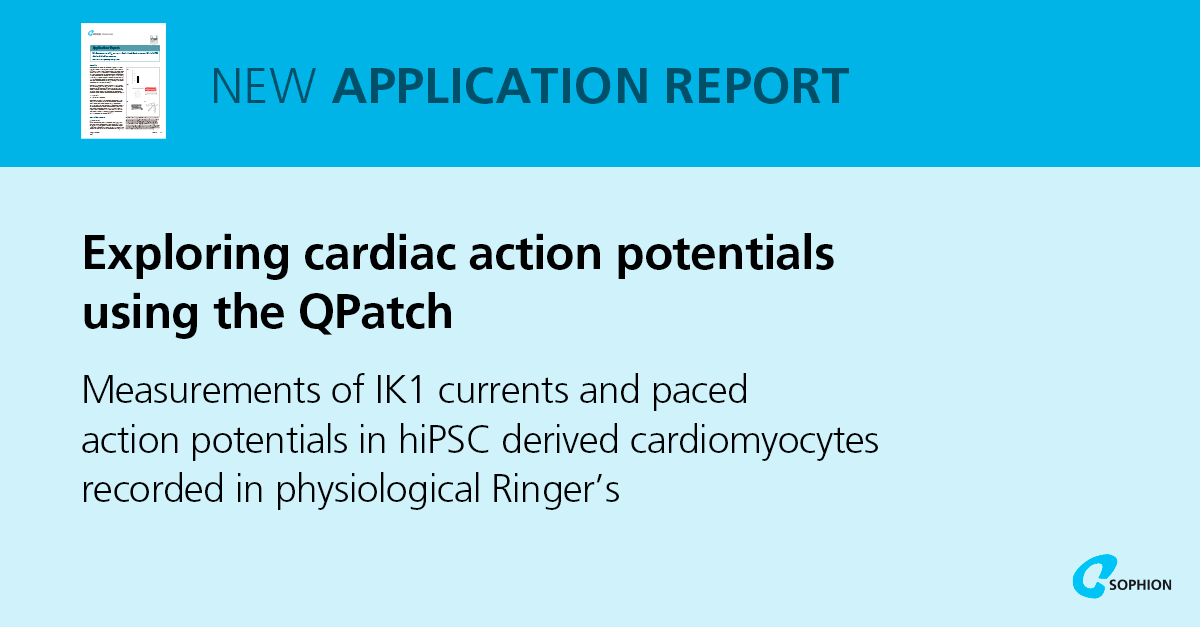
New application report explores cardiac action potentials using the QPatch: insights from mature hiPSC‑CM
The maturation of human induced pluripotent stem cell–derived cardiomyocytes (hiPSC-CMs) is rapidly advancing, enabling more physiologically relevant electrophysiological assays in high throughput formats. In this application report, we summarize key findings from QPatch automated patch clamp (APC) measurements of IK1 currents and paced cardiac action potentials in hiPSC‑CMs. All experiments were conducted in physiological Ringer’s solution – without fluoride or seal‑enhancers.
Cardiac action potentials in hiPSC‑CMs: Toward adult‑like phenotypes
Although immature hiPSC‑CMs often express pacemaker currents (If) and exhibit low IK1 density, recent improvements in cell culture and assay protocols have challenged this paradigm. In our hands, up to 50% of hiPSC‑CMs met quality criteria to yield robust, paced cardiac action potentials (APs) on QPatch. Using a current‑clamp protocol, we captured threshold potential (Vt: –48 mV ± 8 mV), peak potential (Vp: 35 mV ± 9 mV), hyperpolarization potential (Vh: –63 mV ± 6 mV), and AP duration at 90% repolarization (APD90) across 10 cells per plate, with RSDs of 10–26% for Vt–Vp–Vh and ~50% for APD90.
IK1 current measurements: Establishing a mature resting potential
By stepping extracellular [K⁺] from 4 mM to 75 mM and applying 1 mM BaCl₂ to isolate Ba²⁺‑sensitive current, we delineated the IK1 current–voltage relationship in hiPSC‑CMs. Despite a modest overall success rate (~20% per 48 sites), the currents recorded matched expectations for inward rectifier behavior, confirming the presence of functional IK1 channels in 50% of recordings, contributing to a more negative resting membrane potential critical for adult‑like excitability.
Pharmacological modulation of paced action potentials
The increased throughput (10 cells/plate) enabled the construction of concentration–response curves for key cardiac compounds. Addition of Bay K8644 (0.3 µM) prolonged APD90, whereas nifedipine (10 µM) and E4031 (1 µM) shortened or prolonged APD90, respectively. Further, five‑point Boltzmann fits for Bay K8644 and nifedipine produced reliable EC₅₀/IC₅₀ values from single‑cell experiments, illustrating the platform’s suitability for quantitative pharmacology and safety screening.
Driving innovation in drug discovery, safety screening, and disease modeling
As hiPSC‑CM maturity and suspension preparation continue to improve, we anticipate higher success rates and even greater throughput for both IK1 and cardiac action potential assays. Automated patch clamp on QPatch promises to become a frontline tool for cardiac drug screening, disease modeling, and potentially diagnostics.
